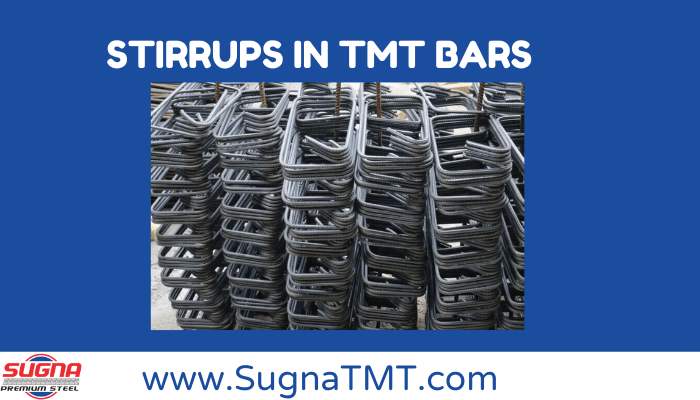In the world of construction, the strength and stability of a structure largely depend on the materials used and the techniques employed during construction. Among the various elements that contribute to the structural integrity of a building, TMT (Thermo-Mechanically Treated) bars play a crucial role. These bars are reinforced with stirrups, which are essential for ensuring the durability and safety of the structure. In this blog post, we will explore the importance of stirrups in TMT bars and how they contribute to enhanced structural integrity.
What Are Stirrups in TMT Bars?
Stirrups are closed-loop steel reinforcements that are used to hold the main TMT bars in place in reinforced concrete structures. They are typically made from mild steel and are bent into various shapes, such as squares or rectangles, depending on the design requirements of the structure. The primary purpose of stirrups is to prevent the buckling of TMT bars under compressive forces and to resist shear and torsion stresses in the structure.
The Role of Stirrups in Structural Integrity

-
Shear Resistance
One of the most critical functions of stirrups is to provide resistance against shear forces. Shear forces can cause a structural element, such as a beam or column, to crack and eventually fail if not properly reinforced. Stirrups are placed perpendicular to the main TMT bars and help distribute these shear forces across the structure, preventing the formation of cracks and ensuring that the load is transferred safely.
-
Preventing Buckling of TMT Bars
TMT bars are designed to bear tensile loads, but when subjected to compressive forces, they can buckle or bend out of shape. Stirrups help prevent this buckling by holding the TMT bars in place, maintaining their alignment, and ensuring that they can withstand compressive loads without deforming. This is particularly important in columns, where the vertical loads can be significant.
-
Enhanced Torsional Strength
Torsional forces, or twisting forces, can occur in structures due to various factors, such as wind loads or uneven settlement of the foundation. Stirrups play a vital role in resisting these torsional forces, especially in beams. By wrapping around the main TMT bars, stirrups help distribute the torsional loads evenly, reducing the risk of structural failure due to twisting.
-
Improved Load Distribution
Stirrups contribute to the overall stability of a structure by improving load distribution. They ensure that the load is evenly spread across the TMT bars, preventing localized stress concentrations that can lead to failure. This is particularly important in beams and columns, where uneven load distribution can cause serious structural issues.
-
Crack Prevention
Concrete, while strong in compression, is relatively weak in tension and can crack under tensile forces. Stirrups help prevent these cracks by providing additional reinforcement to the concrete, particularly in areas where tensile stresses are high. By controlling the development of cracks, stirrups enhance the durability and longevity of the structure.
Types of Stirrups and Their Applications
There are several types of stirrups used in construction, each designed for specific applications:
- Rectangular Stirrups: Commonly used in beams and columns, rectangular stirrups provide resistance against shear forces and help prevent buckling.
- Circular Stirrups: Used in circular columns and piers, circular stirrups provide uniform confinement to the TMT bars and enhance the torsional strength of the structure.
- Helical Stirrups: These stirrups are used in cylindrical structures, such as columns, to provide continuous reinforcement and resist both shear and torsional forces.
The choice of stirrup type and spacing depends on the design requirements and the loads that the structure will bear. Proper placement and spacing of stirrups are crucial for maximizing their effectiveness.
Importance of Proper Placement and Spacing of Stirrups
The effectiveness of stirrups in enhancing structural integrity depends on their proper placement and spacing. If stirrups are spaced too far apart, they may not provide adequate reinforcement, leading to potential structural issues. On the other hand, if they are placed too closely, it can result in an inefficient use of materials and increased construction costs.
Engineers must carefully calculate the required spacing and placement of stirrups based on the expected loads and stresses in the structure. Proper placement ensures that the stirrups can effectively resist shear, torsional, and compressive forces, thereby enhancing the overall stability of the structure.
Conclusion
Stirrups play a vital role in ensuring the structural integrity of buildings by providing essential reinforcement to TMT bars. They resist shear and torsional forces, prevent buckling, improve load distribution, and control the formation of cracks in concrete structures. Proper placement and spacing of stirrups are crucial for maximizing their effectiveness, making them an indispensable component in modern construction practices. By understanding and implementing the correct use of stirrups in TMT bars, engineers and builders can significantly enhance the durability and safety of their structures.
By incorporating the appropriate use of stirrups in construction, you not only ensure the longevity of the structure but also contribute to the safety and well-being of its occupants.

